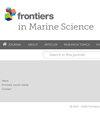Experimental evidence of a mixed breeding strategy and food-dependent maternal and larval traits in chub mackerel
IF 3
2区 生物学
Q1 MARINE & FRESHWATER BIOLOGY
引用次数: 0
Abstract
Food availability plays a critical role in shaping reproductive success of small pelagic fishes, and in natural population, reduced prey access often arises under conditions of intra- and inter-specific density dependence. While energy allocation to egg production has often been viewed along a capital–income continuum, recent studies suggest that reproductive strategies may be more flexible or mixed than previously assumed. However, few studies have empirically examined how the timing and location of prey availability affect reproductive traits in the context of density-dependence. To address this gap, we conducted stable isotope tracer and controlled feeding experiments using chub mackerel (鲐鱼混合繁殖策略及食物依赖性母幼性状的实验证据
食物可得性对小型远洋鱼类的繁殖成功起着至关重要的作用,在自然种群中,在种内和种间密度依赖的条件下,猎物可得性往往会减少。虽然产蛋的能量分配通常被视为资本收入连续体,但最近的研究表明,生殖策略可能比以前假设的更灵活或更混合。然而,很少有研究实证地考察了在密度依赖的背景下,猎物可得性的时间和地点如何影响生殖特征。为了解决这一空白,我们对鲐鱼(Scomber japonicus)进行了稳定同位素示踪和控制摄食实验,以确定摄食条件何时以及如何影响生殖产量。一项利用碳和氮稳定同位素比值进行的饮食转换实验显示,与同类实验中收入养殖的凤尾鱼相比,鲐鱼的同位素转换要慢得多,这表明鲐鱼主要依赖于储存储备(资本繁殖),在产卵期间对饮食资源的依赖有限。产卵前5个月的食物限制显著降低了重复产卵者的躯体状况和产蛋量。与食物充足的雌性相比,食物限制的雌性幼虫表现出较低的生长和饥饿耐受性。这些发现表明,母亲的营养史对产卵量和幼虫性能都有显著影响,强调了在评估密度依赖性繁殖时考虑能量分配策略的重要性。我们的研究结果进一步为讨论太平洋鲐鱼种群生殖产量的近期变化提供了基础,根据产妇营养史及其在生殖成功中的作用。
本文章由计算机程序翻译,如有差异,请以英文原文为准。
求助全文
约1分钟内获得全文
求助全文
来源期刊

Frontiers in Marine Science
Agricultural and Biological Sciences-Aquatic Science
CiteScore
5.10
自引率
16.20%
发文量
2443
审稿时长
14 weeks
期刊介绍:
Frontiers in Marine Science publishes rigorously peer-reviewed research that advances our understanding of all aspects of the environment, biology, ecosystem functioning and human interactions with the oceans. Field Chief Editor Carlos M. Duarte at King Abdullah University of Science and Technology Thuwal is supported by an outstanding Editorial Board of international researchers. This multidisciplinary open-access journal is at the forefront of disseminating and communicating scientific knowledge and impactful discoveries to researchers, academics, policy makers and the public worldwide.
With the human population predicted to reach 9 billion people by 2050, it is clear that traditional land resources will not suffice to meet the demand for food or energy, required to support high-quality livelihoods. As a result, the oceans are emerging as a source of untapped assets, with new innovative industries, such as aquaculture, marine biotechnology, marine energy and deep-sea mining growing rapidly under a new era characterized by rapid growth of a blue, ocean-based economy. The sustainability of the blue economy is closely dependent on our knowledge about how to mitigate the impacts of the multiple pressures on the ocean ecosystem associated with the increased scale and diversification of industry operations in the ocean and global human pressures on the environment. Therefore, Frontiers in Marine Science particularly welcomes the communication of research outcomes addressing ocean-based solutions for the emerging challenges, including improved forecasting and observational capacities, understanding biodiversity and ecosystem problems, locally and globally, effective management strategies to maintain ocean health, and an improved capacity to sustainably derive resources from the oceans.
 求助内容:
求助内容: 应助结果提醒方式:
应助结果提醒方式:


